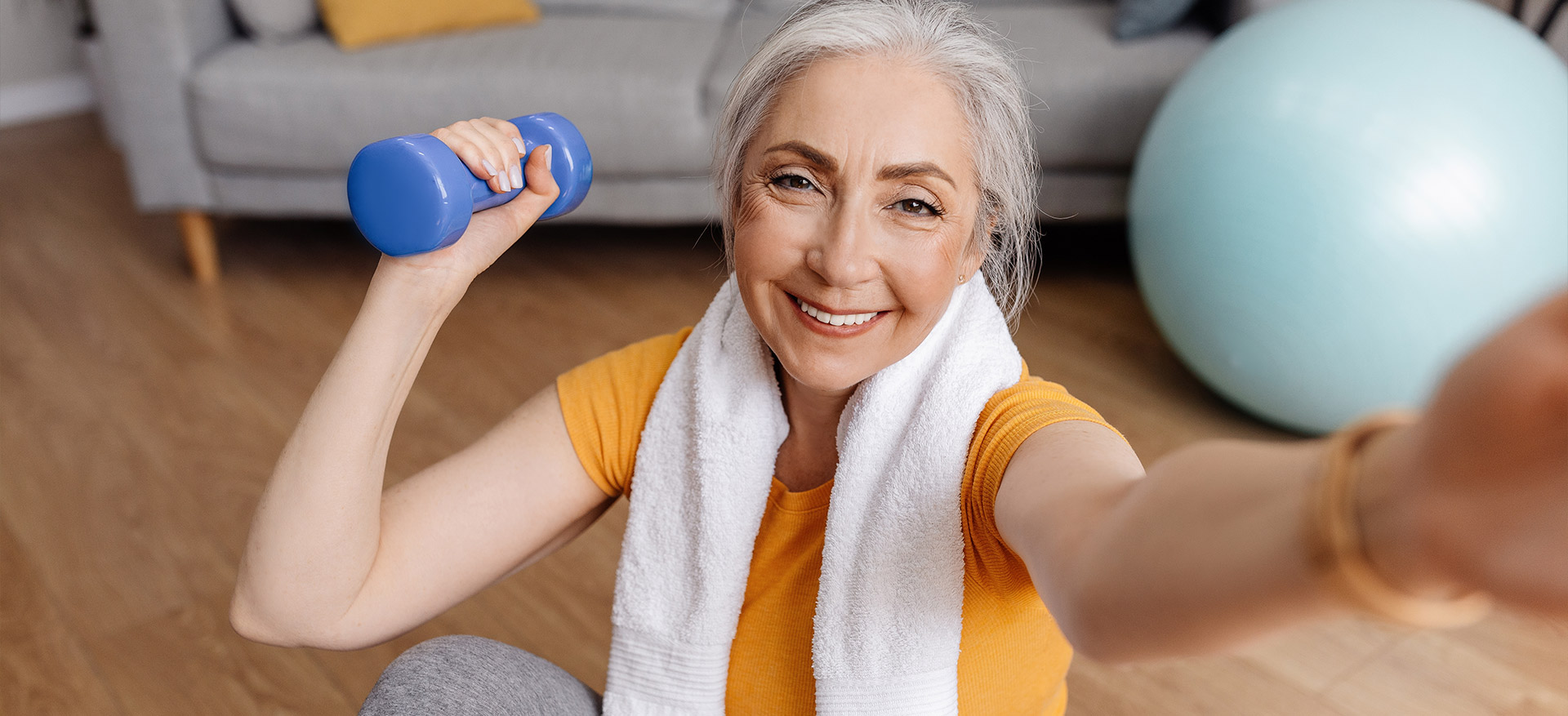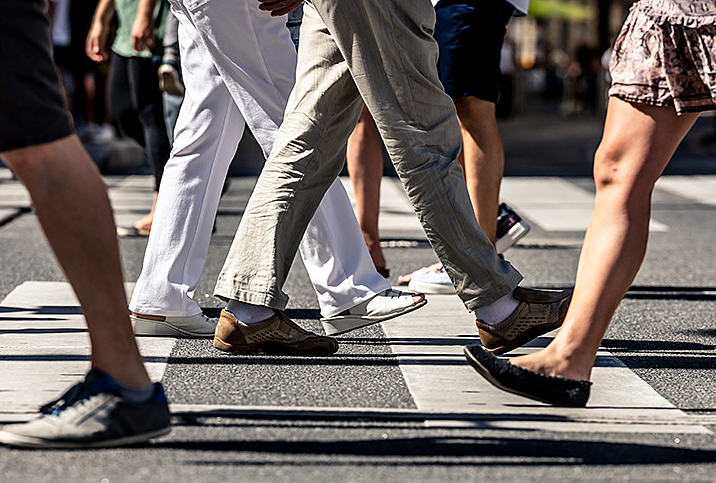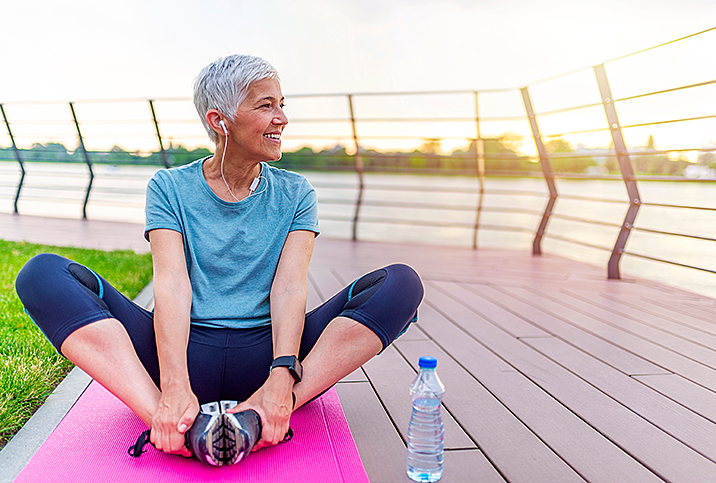The Total Guide to Exercise Over 60

As the saying goes, getting older ain't for sissies. Inevitably, as the years wind on and you've made 60 revolutions around the sun, your body doesn't work quite the same as it did in the past. But just because you creak a little more when you get out of bed or can't run after your grandkids the way you did with your kids, that doesn't mean it's time to throw in the towel. You can over 60.
Starting and maintaining a workout program in your 60s is one of the best things you can do for your long-term health, including your sexual health. You just want to make sure to focus on the exercises and workouts that give you the most bang for your buck.
Start slow, start small, but start
If you haven't been exercising regularly, one of the biggest mistakes you can make is diving into a workout program you might have tried in your 30s or 40s (or even your 50s). While you may still feel young, a new workout program is likely to jolt your system more than it would have years ago.
"The main health challenges I see with this age group relate to the loss of strength, lowered endurance, chronic pain due to injuries or lack of activity, and an overall decrease in coordination and agility," said Laura Flynn Endres, the founder of the Get Fit Done game and a personal trainer in Los Angeles who specializes in training older adults. "These challenges make almost all of the fitness content you come across completely unsafe in a 'too hard, too soon' way."
This means instead of diving into an online workout, even if it's marketed as "beginner," you're best served to work with a trainer to gain insight into your personal strengths and weaknesses and formulate a plan that won't leave you hurting more than before you started.
While you may still feel young, a new workout program is likely to jolt your system more than it would have years ago.
If you're hesitant to sign up with a trainer, do yourself a favor and ease your way into a program.
"Remember, a little exercise is better than no exercise at all," said Linda Pyeatt, senior regional group exercise director and certified personal trainer at YouFit Gyms in Texas. "Start slow. We want to reduce the chance of injury, so easy does it. You will receive so many benefits from just getting your body moving, keeping the blood flowing and building some strength to keep your bones strong."
Pyeatt pointed out that the Centers for Disease Control and Prevention (CDC) has guidelines for exercise specifically geared to people in the 60-plus age group. If you're going to try to follow an exercise schedule, it's not a bad idea to aim for the CDC's suggestions:
- At least 150 minutes a week of moderate-intensity cardiovascular activity, such as brisk walking
- At least two days a week of activities that strengthen the muscles
- At least three days a week of activities to improve balance, such as standing on one foot
Strength training is a must

The phrase "if you have to choose one workout" is a little misleading as there's no reason to choose between strength training, cardio, and flexibility or balance work. You can do all three with the right plan. But both Endres and Pyeatt pointed to strength training as the most important form of exercise to prioritize as you age.
"I think of muscle as the fountain of youth, so while I think walking and cardio are crucial to health, if I had to pick one or the other, I'd choose strength training," Endres recommended. "If you're stronger, you'll organically do more walking because you'll feel amazing and capable."
However, this doesn't mean you should join CrossFit and start throwing around heavy weights during your first week of working out.
"What stands out to me for this demographic is the need for exercise variations that are modified to meet their needs," Endres explained. "For example, even if a client has the strength to do regular bodyweight squats, they might not have the balance to do them safely. In that case, I'll have them squat to a chair or hold on to something sturdy so they can work those muscles without risk or fear of falling."
She also emphasized the importance of including "accessory strength" or "prehab exercises" in a workout program. This type of exercise is designed to bolster strength in areas that will help make traditional strength moves more accessible and safe.
"Think about what a physical therapist might have you do but leveled up a bit," Endres said. "We work the small muscle groups and work on balance and proper movement patterns in order to build a foundation of strength and endurance to do all the other cool exercises."
Exercises that translate to everyday life
When developing a strength training and exercise routine, it's important to think about building strength for life, not just developing muscles that look good in the mirror.
"Incorporate exercises into your workout that mimic the moves of daily activities," Pyeatt said. "For instance, squats are a great functional exercise. Squats mimic getting up and down off the sofa, standing and sitting in the dining room chair or crouching down to pick up your grandchild's toy off the ground."
Endres agreed on the importance of squats and pointed to other key movements to include in a strength routine.
"Step-ups are important so we can continue to use stairs," she said. "Pulling exercises like banded or dumbbell rows are crucial because back pain and weakness and poor posture are so prevalent. Hinge exercises like dead lifts—be careful, though—are necessary because we bend forward to pick things up. Glute-strengthening exercises are key, too. Our glutes get weak from too much sitting and they're not primary movers in most exercises. Add hip bridges to your routine and you're good to go."
Make time for cardio and mobility work
While strength training may be most important, it still represents only one leg of a three-legged stool. While strength training is important, so are cardio and mobility training. While it may seem overwhelming to try to fit different types of workouts into your schedule, it's more doable than you might think.
"As we age, we lose stamina. Our aerobic capacity, muscle strength and endurance decline, but it's not an irreversible fate," Pyeatt explained. "Cardio exercises are a great way to control blood pressure, improve stamina, boost energy, strengthen bones, lower your risk of heart disease and reduce cholesterol levels as well. Cardio exercises can be combined with other activities, like strength training, or they can be done on their own."
Whether you decide to do a combo cardio/strength routine or cardio on its own, it's important to start small and work your way up.
"If you haven't been exercising, don't just jump right to what you did five years ago," Endres said. "Any cardio is better than no cardio, so even five- to 10-minute walks or sessions on a cardio machine are really great. Carefully find your limit of what is bringing on progress but without leaving you exhausted and struggling to recover, and limit the impact on your joints. Opt for exercises that don't pound your joints, as running does. You can run, but you have to work your way up to it and incorporate cross-training exercises to keep your joints healthy."
'Any cardio is better than no cardio, so even five- to 10-minute walks or sessions on a cardio machine are really great.'
Finally, don't overlook the importance of flexibility and mobility work.
"It's a big factor in staying injury-free as we age," Pyeatt said. "Flexibility exercises will decrease injury risk, improve circulation, increase range of motion, alleviate pain and aid in relaxation. We need flexibility for everyday activities, such as turning your head while driving, reaching for things, lifting your arms over your head and even catching your balance if you trip."
While there are lots of ways to work on flexibility and mobility training, Pyeatt pointed to simple yoga poses as a good starting point because yoga can help with balance, coordination and stress. She said you can easily add a simple yoga flow to your routine before or after your workout with exercises such as:
- Child's pose
- Prone press-up
- Cross-body shoulder stretch
- Standing quad stretch
- Hamstring stretch with one foot on a chair
- Pigeon hip stretch
- Overhead side stretch
Translate 'must-dos' into a targeted routine

Knowing you need to add strength training, cardio and mobility work to your daily routine may seem overwhelming. How can you do it without completely rearranging your life? First, you need to figure out how to schedule exercises. Make a plan for when you'll exercise. Aim to carve out 20 to 40 minutes, five to six days per week. But even if you can't carve out the entire time at first, at least make room in your schedule for a 10- or 15-minute walk or yoga routine. Remember, every little bit helps.
Pyeatt suggested a weekly schedule:
- Monday: strength training and walking
- Tuesday: walking and yoga/stretching
- Wednesday: strength training and walking
- Thursday: walking and yoga/stretching
- Friday: strength training
- Saturday: walking
- Sunday: resting
Endres recommended building up your strength-building workouts into a "quickie routine" like this:
- Two exercises for legs (squats, step-ups, lunges, dead lifts, etc.)
- Two exercises for the upper body (inclined pushups, biceps curls, overhead dumbbell presses, band rows, etc.)
- One exercise for abs (curl-ups, planks, dead bugs, etc.)
- One exercise for low back or glutes (bird dog, glute bridge, etc.)
- One exercise for balance (standing on one leg, tightrope walk, etc.)
Perform each exercise you select one to three times, doing 10 repetitions or 45 seconds during each set.
For cardio-based workouts, Pyeatt recommended keeping things simple.
"Take a walk or hike, a bike ride or a swim," Pyeatt said. "Hop on a treadmill or elliptical at the gym. After a warmup, alternate longer intervals of 'easy' with shorter intervals of 'challenging.' On a scale of one to 10, alternate between a four and a seven. Do this for 10 to 20 minutes total."
Just do it
At the end of the day, starting and maintaining an exercise schedule as you age will help keep you self-sufficient and capable into your golden years. Even if you feel a little overwhelmed or intimidated, it's more important to get started with something than to stress over details.
"Less is more," Endres advised. "Think more in terms of what exercises and what dosage will help you stay active and strong and capable but without sacrificing your joint health or pushing so hard you need three days to recover."
Before starting a new workout routine, be sure to consult a physician to ensure you're doing what's best for you.


















